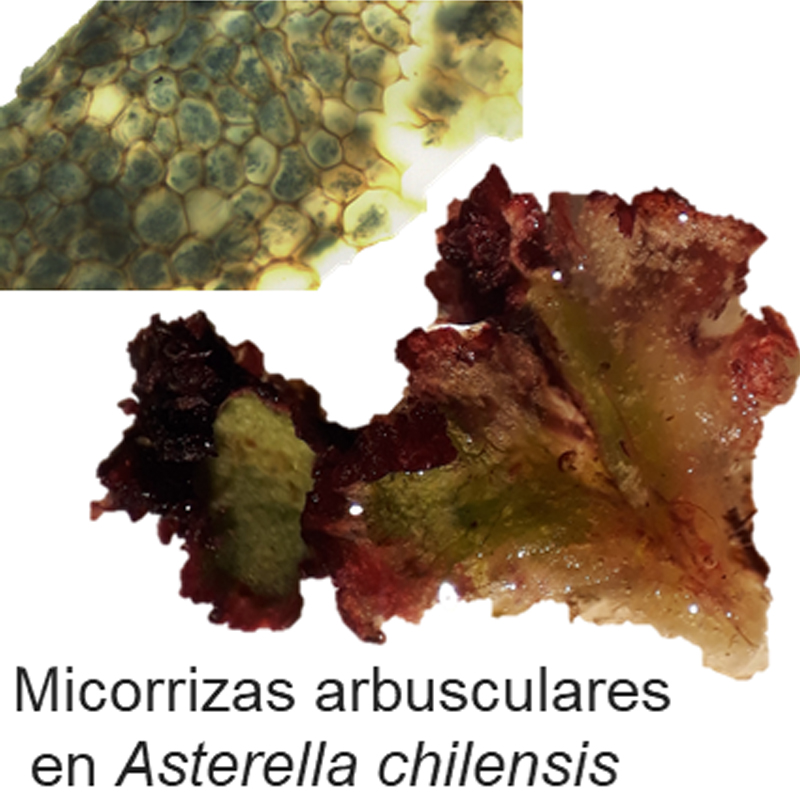New record of arbuscular mycorrhiza in Asterella chilensis (Aytoniaceae, Marchantiophyta), Patagonia, Argentina
DOI:
https://doi.org/10.31055/1851.2372.v57.n1.35364Keywords:
fungal association, liverworts, Paris typeAbstract
Background and aims: The associations that are established between arbuscular mycorrhizae (AM) and bryophytes (Anthocerotophyta, Bryophyta and Marchantiophyta) play an important role in the development of this group of plants. In particular, the relationship between AM and Marchantiophyta has been studied previously in different species and regions of the world and, among other things, it is mentioned that colonization by fungi can differ in abundance and occurrence even in species of the same genus. The objective of this study is to present and characterize for the first time the colonization of AM in Asterella chilensis (Aytoniaceae).
M&M: The examined material comes from collections made in steppe environments of Patagonia, Argentine. The plants were conditioned, stained and analyzed according to specific techniques for bryophytes.
Results: The mycorrhizal association in A. chilensis is described for the first time. A brief description and photographs of the characteristic structures of the AM
are presented. The colonization percentage ranges from 35 to 38% and the AM corresponds to the Paris type, characterized by the presence of aseptate hyphae
forming intracellular arbusculate coils.
Conclusions: The association between AM and a livewort A. chilensis, described here, provides information of this type of associations in taxa and in harsh and little known environments
Downloads
References
BISCHLER-CAUSSE, H., S. R. GRADSTEIN, S. JOVET-AST, D. G. LONG & N. SALAZAR ALLEN. 2005. Marchantiidae. Flora Neotropica Monograph 97: 1-262.
BRUNDRETT, M. 2004. Diversity and classification of mycorrhizal associations. Biological Reviews 79: 473-495.
CARRILLO-SAUCEDO, S. M. & M. E. GAVITO. 2020. Resilience of soil aggregation and exocellular enzymatic functions associated with arbuscular mycorrhizal fungal communities along a successional gradient in a tropical dry forest. Mycorrhiza 30(1): 109-120. DOI: https://doi.org/10.1007/s00572-019-00928-9
COTTET, A. C & M. I. MESSUTI. 2019. New evidence about the interactions between liverworts in the genus Symphyogyna (Pallaviciniaceae) and arbuscular mycorrhizal fungi. Symbiosis 79(2): 117-121. DOI: https://doi.org/10.1007/s13199-019-00634-2
COTTET, A. C., J. M. SCERVINO & M. I. MESSUTI. 2018. An improved staining protocol for the assessment of arbuscular mycorrhizal in bryophytes. Bol. Soc. Argent. Bot. 53(2): 201-206. DOI: https://doi.org/10.31055/1851.2372.v53.n2.20577
DICKSON, S. 2004. The Arum-Paris continuum of mycorrhizal symbioses. New Phytol. 163(1): 187-200. DOI: https://doi.org/10.1111/j.1469-8137.2004.01095.x
FIELD, K. J., W. R. RIMINGTON, M. I. BIDARTONDO, K. ALLISON, D. J. BEERLING, D. D. CAMERON, J. G. DUCKETT, J. R. LEAKE Y S. PRESSEL. 2016. Functional analysis of liverworts in dual symbiosis with Glomeromycota and Mucoromycotina fungi under a simulated Palaeozoic CO2 decline. ISME Journal 10: 1514-1526. DOI: https://doi.org/10.1038/ismej.2015.204
DELAUX, P. M. & S. SCHORNACK. 2021. Plant evolution driven by interactions with symbiotic
and pathogenic microbes. Science 371, eaba6605. DOI: https://doi.org/10.1126/science.aba6605
FRAHM, J. P. 2003. Manual of tropical bryology. Trop. Bryol. 23(1): 1-200. DOI: https://doi.org/10.11646/bde.23.1.1
GRADSTEIN S. R. & D. PINHEIRO DA COSTA. 2003. The Hepaticaea and Anthocerotae of Brazil. Mem. N. Y. Bot. Gard. 87:1-318.
LIEPINA, L. 2012. Occurrence of fungal structures in bryophytes of the boreo-nemoral zone. Env. Exp. Biol. 10(1): 35-40.
LIGRONE R., A. CARAFA, E. LUMINI, V. BIANCIOTTO, P. BONFANTE & J. G. DUCKETT. 2007. Glomeromycotean associations in liverworts: a molecular, cellular, and taxonomic. Am J. Bot. 94(11):1756-1777. DOI: https: //doi.org/10.3732/ajb.94.11.1756.
MARTIN, F. 2016. Molecular Mycorrhizal Symbiosis. Ed. John Wiley & Sons, Inc. New Jersey, USA. 506 pp. DOI: https://doi.org/10.1002/9781118951446
NELSON, J. & A. J. SHAW. 2019. Exploring the natural microbiome of the model liverwort: fungal endophyte diversity in Marchantia polymorpha L. Symbiosis 78(1): 45-59.
ÖPIK, M., A. VANATOA, E. VANATOA, M. MOORA, J. DAVISON, J. M. KALWIJ, U. REIER & M. ZOBEL. 2010. The online database MaarjAM reveals global and ecosystemic distribution patterns in arbuscular mycorrhizal fungi (Glomeromycota). New Phytol. 188(1): 223-241. DOI: https: //doi.org/10.1111/j.1469-8137.2010.03334.x
SCHUBLER A, SCHWARZOTT D, WALKER C, 2001. A new fungal phylum, the Glomeromycota: phylogeny and evolution. Mycological Research 105: 1413-1421.
SMITH, F. A. & S. E. SMITH. 1997. Tansley Review N° 96. Structural diversity in (vesicular)-arbuscular mycorrhizal symbioses. New Phytol. 137(3): 373-388. DOI: https://doi.org/10.1046/j.1469-8137.1997.00848.x
SÖDERSTRÖM, L., HAGBORG, A., VON KONRAT, M., BARTHOLOMEW-BEGAN, S., BELL, D., BRISCOE, L., BROWN, E., CARGILL, D. C., COSTA, D. P., CRANDALL-STOTLER, B. J., COOPER, E. D., DAUPHIN, G., ENGEL, J. J., FELDBERG, K., GLENNY, D., GRADSTEIN, S. R., HE, X., HEINRICHS, J., HENTSCHEL, J., ILKIU-BORGES, A. L., KATAGIRI, T., KONSTANTINOVA, N. A., LARRAÍN, J., LONG, D. G., NEBEL, M., PÓCS, T., PUCHE, F., REINER-DREHWALD, E., RENNER, M. A., SASS-GYARMATI, A., SCHÄFER-VERWIMP, A., MORAGUES, J. S., STOTLER, R. E., SUKKHARAK, P., THIERS, B. M., URIBE, J., VÁŇA, J., VILLARREAL, J. C., WIGGINTON, M., ZHANG, L., & ZHU, R. 2016. World Checklist of Hornworts and Liverworts. PhytoKeys, 59, 1-828. http://dx.doi.org/10.3897/phytokeys.59.6261
SPATAFORA, J. W., Y. CHANG, G. L. BENNY, K. LAZARUS, M. E. SMITH, M. L. BERBEE, G. BONITO, N. CORRADI, I. GRIGORIEV, A. GRYGANSKYI, T. Y. JAMES, K. O’DONNELL, R. W. ROBERSON, T. N. TAYLOR, J. UEHLING, R. VILGALYS, M. M. WHITE & J. E. STAJICH. 2016. A phylum-level phylogenetic classification of zygomycete fungi based on genome-scale data. Mycologia 108(5): 1028-1046. DOI: https://doi.org/10.3852/16-042

Published
How to Cite
Issue
Section
License
Copyright (c) 2022 Agustina Celeste Cottet, María Inés Messuti

This work is licensed under a Creative Commons Attribution-NonCommercial-NoDerivatives 4.0 International License.
Provides immediate and free OPEN ACCESS to its content under the principle of making research freely available to the public, which fosters a greater exchange of global knowledge, allowing authors to maintain their copyright without restrictions.
Material published in Bol. Soc. Argent. Bot. is distributed under a Creative Commons Attribution-NonCommercial-ShareAlike 4.0 International license.








